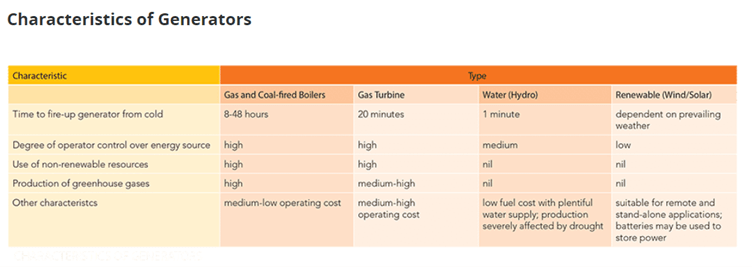What is ‘energy transition’?
The ‘energy transition’ refers to the energy sector moving away from traditional fossil-fuel electricity generation (oil, gas and coal) towards sustainable and low carbon energy sources (solar, wind, biomass, hydrogen, and water).
The energy transition is occurring worldwide, driven by changes to energy supply, demand, and prices, and the need to reduce energy-related greenhouse gas emissions.
While the transition will require significant investment and change, it will also provide opportunities for employment, economic development and social investment.
Why does the energy system in NSW need to change?
Currently, around 70 percent of the state’s electricity comes from coal-fired power stations. Over the next 15 years four of the five stations in NSW will be retired due to their age.
Replacing the existing energy generation with new generation will take time. We must start planning now so the required infrastructure is in place to ensure electricity consumers in New South Wales have affordable, clean and reliable electricity supply as coal powered stations close.
Why are we transitioning to renewable energy?
Renewable energy is cleaner and cheaper than fossil-fuel generated energy.
Since 2018, CSIRO’s GenCost reports have found firmed renewable energy from a mix of solar and wind remain the cheapest source of new-build electricity generation in Australia.
As demonstrated in the table below, energy generated by renewable resources produces no greenhouse gas emissions. However, because renewable generation relies on variable inputs like wind, water and sun, there is a lower level of control over the generators.

source: https://www.aer.gov.au/system/files/State%20of%20the%20energy%20market%202007.pdf
Some traditional electricity generators can increase or decrease their production of electricity to respond to the demand of consumers.
As renewable energy generation is generally weather dependent, we need to make sure power is available when needed. Energy storage infrastructure allow renewable energy to be stored and released when needed to help maintain the reliability and security of the electricity system.
What does reliability and security of the system mean?
Security and reliability refer to the system’s ability to respond to any expected or unexpected events, like routine maintenance of equipment or a bushfire.
Security is the energy system’s capacity to continue to operate even if one part of the system is disconnected. For example, if a power station needs to be taken offline for maintenance, security means there is a back-up plan in place to ensure we still have enough power to meet electricity needs while that power station is offline.
Reliability, on the other hand, is the power system’s capacity to supply enough energy, even in times of peak demand, like during a heat wave.
Where will the renewable energy be sourced from?
Our new power sources will no longer be centred in a handful of locations near coal supply, but instead will be decentralised across the State, focused in at least five Renewable Energy Zones (REZs). The zones group renewable generation, transmission and storage infrastructure in strategic locations where there is high-quality renewable resources and the energy generated can be efficiently stored and transmitted across NSW when needed.
Five REZs have been declared in New South Wales: Central-West Orana, New England, South-West, and Hunter-Central Coast and Illawarra.
Why do we require investment in transmission?
The NSW transmission grid was built to deliver energy from coal-fired power stations to the areas of highest demand (like cities). Upgrades to the existing transmission grid and new transmission infrastructure will be required to connect the new electricity generation and storage to the power system.
Social and economic benefits of energy transition
In addition to providing reliable clean energy for NSW consumers, the REZs will help service the growing energy needs of emerging green manufacturing, energy intensive agriculture and export market opportunities.
The energy transition is expected to create thousands of jobs across regional NSW, enable new industries to grow, and provide economic and social benefits to the regions.
The NSW Renewable Energy Sector Board (the Board) has prepared a plan for the NSW renewable energy sector that sets out how to cost-effectively maximise the use of locally produced and supplied goods and services, and local workers under the Electricity Infrastructure Roadmap (the Roadmap). The plan also considers how to foster opportunities for apprentices and trainees.
AEMO Services, as the NSW Consumer Trustee, has incorporated the Board’s recommendations into the inaugural tender for energy generation and long-duration storage under the Roadmap.
The Office of Energy and Climate Change (OECC) has also published the First Nations Guidelines (the Guidelines) and Central-West Orana region specific guidelines, which provide details about best practice approaches to consultation and negotiation with local Aboriginal communities. A Project Steering Committee made up of First Nations and government stakeholders is overseeing the development of the guidelines. A region-specific guideline will be developed for each REZ.
The Guidelines will help to ensure that the economic benefits of the energy transition under the Roadmap are shared with local Aboriginal businesses and communities and provide support to build skills and capacity to take advantages of opportunities into the future.
What’s the role of AEMO Services?
AEMO Services’ role is as the NSW Consumer Trustee, an independent body appointed by the Minister for Energy under the Electricity Infrastructure Investment Act 2020 to carry out competitive tenders to facilitate this investment, authorisation of REZ transmission infrastructure, and provide financial risk management and advice.
We work to ensure the market meets NSW’s long-term needs, providing access to affordable, secure and reliable energy for households and businesses.
Sources
www.csiro.au
www.aer.gov.au/state-of-the-energy-market-2007.pdf
www.energyco.nsw.gov.au
www.energy.nsw.gov.au/NSW-Electricity-Infrastrcture-Roadmap-Overview.pdf
www.energy.nsw.gov.au
Last updated 12 Oct 2023
